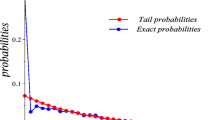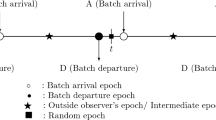Abstract
An elegant and simple solution to determine the distributions of queue length at different epochs and the waiting time for the model \(GI^{X}/M/c\) is presented. In the past, the model \(GI^{X}/M/c\) has been extensively analyzed using various techniques by many authors. The purpose of this paper is to present a simple and effective derivation of the analytic solution for pre-arrival epoch probabilities as a linear combination of specific geometric terms (except for the boundary probabilities when the number of servers is greater than the maximum batch size) involving the roots of the underlying characteristic equation. The solution is then leveraged to compute the waiting-time distributions of both first and arbitrary customers of an incoming batch. Numerical examples with various arrival patterns and batch size distributions are also presented. The method that is being proposed here not only gives an alternate solution to the existing methods, but it is also analytically simple, easy to implement, and computationally efficient. It is hoped that the results obtained will prove beneficial to both theoreticians and practitioners.
Similar content being viewed by others
References
Abol’nikov, L.M.: A multichannel queueing system with group arrival of demands. EngngCybernet 4, 39–48 (1967)
Breuer, L., Baum, D.: An Introduction to Queueing Theory and Matrix-Analytic Methods. Springer, Berlin (2005)
Burke, P.J.: Delays in single-server queues with batch input. Ops Res. 23, 830–833 (1975)
Chakka, R.: Performance and Reliability Modelling of Computing Systems Using Spectral Expansion, Ph.D. Thesis, Department of Computing Science, University of Newcastle, University of Newcastle Upon Tyne (1995)
Chaudhry, M.L.: QROOT Software Package. A&A Publications, Kingston (1991)
Chaudhry, M.L., Harris, C.M., Marchal, W.G.: Robustness of root finding in single-server queueing models. INFORMS J. Comput. 2, 273–286 (1990)
Chaudhry, M.L., Templeton, J.G.C.: A First Course in Bulk Queues. Wiley, New York (1983)
Cromie, M.V., Chaudhry, M.L., Grassmann, W.K.: Further results for the queueing system \(M^{X}/M/c\). J. Oper. Res. Soc. 20(8), 755–763 (1979)
Daigle, J.N., Lucantoni, D.M.: Queueing systems having phase-dependent arrival and service rates. In: Stewart, W.J. (ed.) Numerical Solutions of Markov Chains. Marcel Dekker Inc, New York (1991)
Ferreira, F., Pacheco, A.: Analysis of \(GI^{X}/M/s/c\) systems via uniformisation and stochastic ordering. In Czachórski T., Pekergin, N. (eds), Proceedings of First Workshop on New Trends in Modelling. Quantitative Methods and Measurement, Zakopane, Poland, 27/06/2004-29/06/2004, pp. 97–133 (2004)
Gontijo, G.M., Atuncar, G.S., Cruz, F.R.B., Kerbache, L.: Performance Evaluation and Dimensioning of \(GI^{X}/M/c/N\) Systems through Kernel Estimation. Mathematical Problems in Engineering (2011). doi:10.1155/2011/348262
Gouweleeuw, F.N.: A general approach to computing loss probabilities in finite-buffer queues, Ph.D. thesis, Vrije Universiteit, Amsterdam (1996)
Gross, D., Harris, C.M.: Fundamentals of Queueing Theory, vol. 4. Wiley, New York (2008)
Holman, D.F., Chaudhry, M.L.: Some results for the queueing system \(E_k^X /M/c\). Naval Res. Logist. Q. 2, 217–222 (1980)
Janssen, A.J.E.M., van Leeuwaarden, J.S.H.: Analytic computation schemes for the discrete-time bulk service queue. Queueing Syst. 50, 141–163 (2005)
Kabak, I.W.: Blocking and delays in \(M^{X}/M/c\) bulk arrival queueing system. Mgmt Sci. 17, 112–115 (1970)
Kim, B., Choi, B.D.: Asymptotic analysis and simple approximation of the loss probability of the \(GI^{X}/M/c/K\) queue. Perform. Eval. 54(4), 331–356 (2003)
Laxmi, P.V., Gupta, U.C.: Analysis of finite-buffer multi-server queues with group arrivals: \(GI^{X}/M/c/N\). Queueing Syst.: Theory Appl. 36, 125–140 (2000)
Maity, A., Gupta, U.C.: A comparative numerical study of the spectral theory approach of Nishimura and the roots method based on the analysis of BDMMAP/G/1 queue. Int. J. Stoch. Anal. 958780, 9 (2015)
Neuts, M.F.: An algorithmic solution to the GI/M/c queue with group arrivals. Cahiers de C.E.R.O. 21, 109–119 (1979)
Wolff, R.W.: Poisson arrivals see time averages. Oper. Res. 30(2), 223–231 (1982)
Yao, D.W., Chaudhry, M.L., Templeton, J.G.C.: A note on some relations in the queue \(GI^{X}/M/c\). Oper. Res. Lett. 3, 53–56 (1984)
Zhao, Y.Q.: Analysis of the \(GI^{X}/M/c\) model. Queueing Syst. 15, 347–364 (1994)
Zhao, Y.Q.: Counter examples to a conjecture on bounds for the loss probability in finite-buffer queues. Probab. Eng. Inf. Sci. 13, 221–227 (1999)
Acknowledgments
This research was supported (in part) by the Department of National Defence Applied Research Program Grant GRC0000B1638. We would like to sincerely thank the referees for their constructive comments and insights which lead to a much more polished paper.
Author information
Authors and Affiliations
Corresponding author
Appendices
Appendix A
Linear difference equations have frequently been used in the theory of queues (see Chaudhry and Templeton [7]). Their application in solving \(GI^{X}/M/c\) is explained below. First, by rearranging (1), we have
Now, substituting \(p_j^- =Cz^{j}, j\ge \max \left( {c,r} \right) \) into the above expression leads to
which is the underlying characteristic equation of \(GI^{X}/M/c\). To prove that (2) has r roots inside the unit circle \(\left| z \right| =1\), let us rewrite this equation as
Now let
and
Consider absolute values of \(f\left( z \right) \) and \(g\left( z \right) \) on the circle \(\left| z \right| =1-\delta \), where \(\delta \) is positive and sufficiently small. This gives
and
which leads to
or
where \(\rho =\frac{\lambda \mu _X }{c\mu }\). Thus, for \(\rho <1\) and \(\delta \) sufficiently small, \(\left| {f\left( z \right) } \right| >\left| {g\left( z \right) } \right| \) on \(\left| z \right| =1-\delta \). Since \(f\left( z \right) \) and \(g\left( z \right) \) satisfy the conditions of Rouché’s theorem, it follows that (2) has r roots inside the unit circle.
Appendix B
If the two t.p.m.’s of \(GI^{X}/M/c\) are \(\left[ {P_{i,j} } \right] _{c\le r}\) when \(c\le r\) and \(\left[ {P_{i,j} } \right] _{c>r}\) when \(c>r\), respectively, then
and
Rights and permissions
About this article
Cite this article
Chaudhry, M.L., Kim, J.J. Analytically elegant and computationally efficient results in terms of roots for the \(GI^{X}/M/c\) queueing system. Queueing Syst 82, 237–257 (2016). https://doi.org/10.1007/s11134-015-9469-3
Received:
Revised:
Published:
Issue Date:
DOI: https://doi.org/10.1007/s11134-015-9469-3




